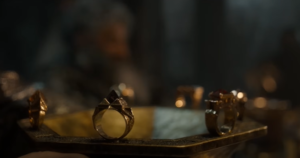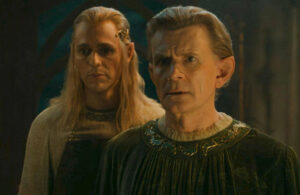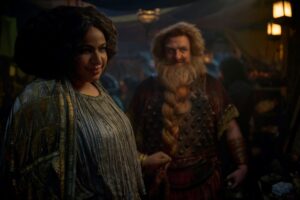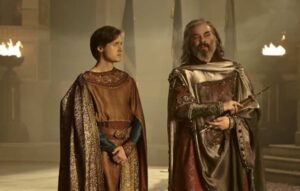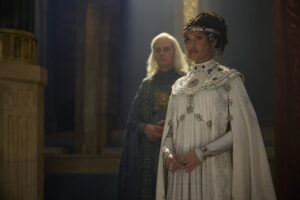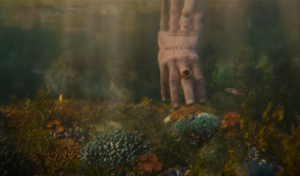SPOILERS FOR THE RINGS OF POWER SEASON TWO AHEAD!
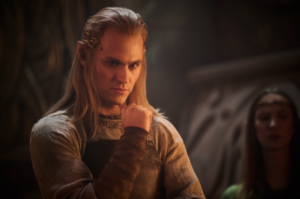
Credit: Ben Rothstein / Prime Video
Just before the premiere of Amazon’s The Lord Of The Rings: The Rings Of Power season two in late August, I had the pleasure of speaking with the epic fantasy series’ costume designer, Luca Mosca. We touched on Sauron and Tom Bombadil, but at the time, he couldn’t tell me much about specific characters and their costumes. Now that the season is over, I sat down for another interview with Mosca to talk a little bit more in-depth about the season, specific costumes, and his experience working on The Rings Of Power.
Leith Skilling: So I wanted to start by first saying congratulations to you and your entire team. Season two was so well-received, and the costumes were just beautiful across the board.
Luca Mosca: Thank you so much. I should really stress on the word “Team”, because I was nothing in the face of the skills and professionality and efficiency of my entire Team. Not one of those costumes would be there were it were not for the Team. It takes a village and it’s really like a bee-hive operation and I’ve been chosen to be the queen bee. And everybody around me was just pure excellence. So I wanted to make sure that you are aware that you’re not talking to one person but you’ll be talking to hundreds.
LS: Especially on a production of this scale, I can only imagine how many people are involved at every level.
LM: I think we have been the largest TV show ever made. In New Zealand in particular, one really had the feeling that we were doing something colossal and immense.
LS: Well, on that note, how did you get involved with The Rings Of Power?
LM: I got a call out of the clear blue sky from one of the executive producers who explained that they were sadly losing their costume designer [Kate Hawley] and who invited me to join the show in New Zealand, so I interviewed, put together a few sketches and I was hired.
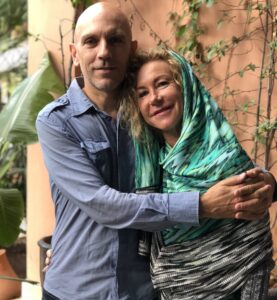
I was coming from the John Wick trilogy but could not join John Wick 4 because I had to go to Italy and join my family for a couple of months because my little sister who had gone skiing off-trail had met her death together with her boyfriend in an avalanche and I had to go tend to my elderly father who had been left alone. That was a true emotional cataclysm in my life. Once my father was taken care of, I was able to leave my dad in capable hands, fly to New Zealand and join the show. It was the proverbial “rollercoaster” or the “peaks and valleys” of life.
LS: Had you read the books or was this world entirely new to you?
LM: Although I was familiar with the trilogy, I read the books again in order to become an “expert” but here’s another intimidating thing: you think you know Lord Of The Rings because you know Saruman and Gollum but then you go into this kind of production and you are surrounded by so much knowledge and you hear people talk and it’s like “what are they talking about?” It’s gigantic, it’s a culture, it’s a language of its own, there are people who know how to write the runes and people who know how to read them, people who know everything and every single detail inside-out, it was an intimidating feeling.

Credit: Ben Rothstein / Prime Video
LS: We have to talk about Sauron, because he really is the center of season two. There’s so much fan art that’s been made of Sauron in his “fair form” as Annatar: did you try to reference any of that, and what other references and influences went into creating his new look?
LM: I had to tap into my background, my culture and my heritage and I started researching how in the Middle Ages a good monk would be depicted or a good prophet or a good Samaritan or a good messenger, since we drew a lot of visual inspiration from Middle Ages art or from the Byzantine period or from the Renaissance. One feature of that costume is that it is very drapey even if it looked like it was made out of burlap. The fabric was actually a precious raw silk that looked like burlap because the weave was open and rustic looking. We used this open weave quality and underneath it we put a shiny, silvery fabric that – only at times, only with movement when the knee or the elbow or the chest were pushing against the fabrics and only in places of contact – it shimmered through.
And that to me was one of the most successful costumes because it showed the “deceit” of Sauron: “Oh, look at me, I’m a humble creature, I’m a humble man, I’m dressed in burlap like a poor monk begging for scraps of food”. But in reality, if you dug through his costume, you would find all this decadent luxury underneath the first layer of fabric that is not typical of a monk. It was a beautiful concept and this is what we do as costume designers since we are storytellers and sometimes we even inform the actor of who their character is. Actors sometimes meet their character in front of a mirror in the fitting room, and Charlie Vickers loved that costume.
LS: Sauron and Galadriel obviously have a very close relationship and their journeys parallel each other this season. Do you design one’s outfit with the other one in mind?
LM: Absolutely. Always, always. We prepare “line-ups” of costumes: the illustrations are all lined up on a sheet of paper or on a board, to make sure – and this is something I do in every movie – to make sure that there are no clashes, or no similarities, or if there are similarities, they happen on purpose. Only once I display them out, only after seeing them all together I realize conflicts or issues, so yes: we do design costumes with that in mind, with a palette in mind and the costume of Sauron, the “fair form” at least, had a little bit of an Elven quality. It wasn’t the coloring of Celebrimbor, it wasn’t the greens and the purples of Eregion, but in terms of drape and fluidity and shape, it could very well pass for an Elf. So we do design these things with that in mind, and if you think about it, Sauron’s “fair form” is the same color as Galadriel’s armor, right?
LS: There’s been some speculation online over the similar silhouette and color palette of Sauron’s “fair form” costume and the costume of Celeborn, Galadriel’s husband, in The Lord Of The Rings films – was there any intent behind that?
LM: Not at all, that is not something that we had in mind or that we intended to reference.
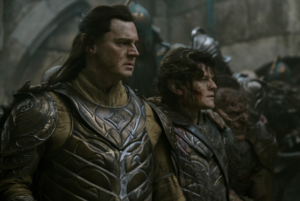
Credit: Ben Rothstein / Prime Video
LS: Is foreshadowing something that you try to incorporate into the costuming? A lot of characters die this season – Celebrimbor, Adar, King Durin – are there any signals to their eventual fates that you incorporate into the costume?
LM: I try to, as much as possible, because us costume designers are psychologists and we try to give hints but sometimes like in the case of the death of Celebrimbor, it’s in the lore and is a known fact, the audience knows in advance. Celebrimbor’s look was one of the big tasks that I was met with when I landed in New Zealand. The Studio wanted a dignified, elegant and elevated Celebrimbor. And again, tapping back into my heritage of history and art, I thought that the best reference for Celebrimbor would have been Dante. Next time you see images of Dante or Dante with Beatrice, note how that kind of fluid gown is kind of translated into Celebrimbor’s costume. This kind of artistic “concept” is very seductive for the audience, for the director, for the actor or the producer. That was another successful translation of cultural elements from my particular background into modern filmmaking.
LS: Do you have a favorite group to design for; Elves, Dwarves, Númenóreans?
LM: You’re basically asking me as a parent to choose his favorite child – that’s impossible! So without telling you what was my favorite or my least-favorite – I can tell you that honestly I did not have a least-favorite, because every world and culture of Rings Of Power was so creatively enjoyable to design and I could go from looking at a bloodied Orc to seeing a celestial Elf during the same costume fitting session and the mental and creative stimulation of going from from Dwarves to Númenóreans or from Orcs to Elves was so satisfying. I particularly loved Númenor. Númenor is to me like ancient Rome at the peak – but at that last day of the peak, when after that the fall of the empire happened. It was at the peak of luxury and decadence and refinement with beautiful fabrics, shiny jewel-tones or primary colors. The Elves were elegant and the Orcs were so creative and designing for the Dwarves was so incredible, but Númenor was a feast of colors, of luxury, of embroidery, it was phenomenal.
LS: When designing armor, what is the process behind that, and especially for the Elves, how do you balance the beauty and aesthetics with practicality and durability?
LM: The first armor that I was tasked to design was for the elven army of Eregion. We looked at brass statues that were becoming tarnished with the verdigris of oxidation. And in my understanding of Eregion – and that’s why I used so much green in it, green and colors of foliage – in Eregion they were master builders and their city was incredible but they never prevented nature from coming indoors. So moss, lichen and creeping ivy were not trimmed but they were invited in and they were part of the environment. So the oxidation concept came up and I applied green “verdigris” to the armor.
How do we make them durable? Durability is a big problem, because much of the armor, just because of the nature of it, goes through battles with a lot of action and gets damaged. But the armor also needs to be made out of materials that are light and safe enough for the actor to wear. Can you only imagine if there were a sharp metal edge and I sent the actor out in it and they fell and got cut and injured? So the choice of materials is very important and is part of a long process. When I pass on the final sketch to the armorer who asks me: “are you sure?”, the little voice inside me says “No, I’m not! I will never be sure, give me another day, give me another week, give me another month”. But we have to move on and to commit to a specific design and to give it to a sculptor who first makes it in clay and also to a metalworker who makes a prototype out of real metal. At that stage I have to pull the trigger and say “this is it” and there’s no going back. For Gil-galad or Elrond the armor was slightly different and personalized, it was similar to the rest of the soldiers yet with slight differences and touches that made it unique to them.
LS: Where do the costumes currently reside?
LM: They’re all back in London at the Studios. As you could see there were a lot of costumes from season one in season two, and costumes from both seasons will also be carried over into the next seasons.
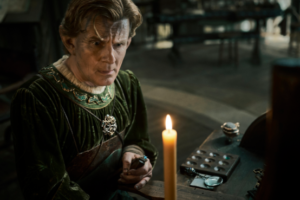
Credit: Ross Ferguson / Prime Video
LS: Lastly, a silly question. When the Lord Of The Rings films came out, there were Barbie dolls of characters like Arwen, Galadriel, Legolas. Is there any chance of a Sauron Barbie doll or a Galadriel Barbie doll for The Rings Of Power?
LM: (laughs) I don’t know, because I’m not involved with that side of marketing. What I do know is that there was a doll of John Wick in the black suit that was not made by the Studio. So these dolls might exist but I am unaware of them.
LS: We have to get on Amazon’s case to make the official versions.
LM: I will definitely make a request and say that Leith requested Barbie dolls.
LS: Well, that is all the time we have. Thank you so much for your time.
LM: You have to shut me up because I could continue for hours as I like to reminisce about all of this; it was a beautiful experience. Let’s hope that the costumes get – that the whole series in general, the actors and the sets and everybody – get the due recognition during awards season.
LS: Emmys all around!
LM: I’m not a big social media person so I don’t have a “thermometer” of what’s going on but I hear a lot of positive stuff so – fingers crossed!
All episodes of The Lord Of The Rings: The Rings Of Power season two are now streaming on Amazon Prime Video.
This interview has been edited for length and clarity.
